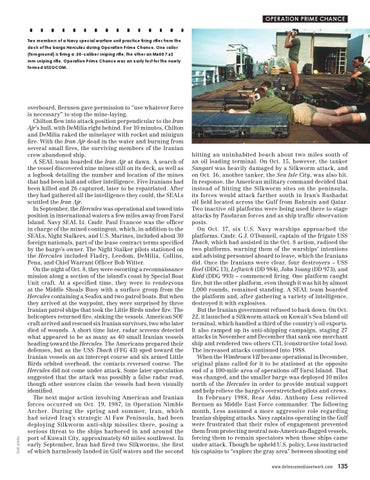operation PRIME CHANCE
Two members of a Navy special warfare unit practice firing rifles from the deck of the barge Hercules during Operation Prime Chance. One sailor (foreground) is firing a .50-caliber sniping rifle, the other an M600 7.62 mm sniping rifle. Operation Prime Chance was an early test for the newly
DoD photo
formed USSOCOM.
overboard, Bernsen gave permission to “use whatever force is necessary” to stop the mine-laying. Chilton flew into attack position perpendicular to the Iran Ajr’s hull, with DeMilia right behind. For 10 minutes, Chilton and DeMilia raked the minelayer with rocket and minigun fire. With the Iran Ajr dead in the water and burning from several small fires, the surviving members of the Iranian crew abandoned ship. A SEAL team boarded the Iran Ajr at dawn. A search of the vessel discovered nine mines still on its deck, as well as a logbook detailing the number and location of the mines that had been laid and other intelligence. Five Iranians had been killed and 26 captured, later to be repatriated. After they had gathered all the intelligence they could, the SEALs scuttled the Iran Ajr. In September, the Hercules was operational and towed into position in international waters a few miles away from Farsi Island. Navy SEAL Lt. Cmdr. Paul Evancoe was the officer in charge of the mixed contingent, which, in addition to the SEALs, Night Stalkers, and U.S. Marines, included about 30 foreign nationals, part of the lease contract terms specified by the barge’s owner. The Night Stalker pilots stationed on the Hercules included Fladry, Leedom, DeMilia, Collins, Pena, and Chief Warrant Officer Bob Witter. On the night of Oct. 8, they were escorting a reconnaissance mission along a section of the island’s coast by Special Boat Unit craft. At a specified time, they were to rendezvous at the Middle Shoals Buoy with a surface group from the Hercules containing a Seafox and two patrol boats. But when they arrived at the waypoint, they were surprised by three Iranian patrol ships that took the Little Birds under fire. The helicopters returned fire, sinking the vessels. American SOF craft arrived and rescued six Iranian survivors, two who later died of wounds. A short time later, radar screens detected what appeared to be as many as 40 small Iranian vessels heading toward the Hercules. The Americans prepared their defenses, but as the USS Thach (FFG 43) sped toward the Iranian vessels on an intercept course and six armed Little Birds orbited overhead, the contacts reversed course. The Hercules did not come under attack. Some later speculation suggested that the attack was possibly a false radar read, though other sources claim the vessels had been visually identified. The next major action involving American and Iranian forces occurred on Oct. 19, 1987, in Operation Nimble Archer. During the spring and summer, Iran, which had seized Iraq’s strategic Al Faw Peninsula, had been deploying Silkworm anti-ship missiles there, posing a serious threat to the ships harbored in and around the port of Kuwait City, approximately 60 miles southwest. In early September, Iran had fired two Silkworms, the first of which harmlessly landed in Gulf waters and the second
hitting an uninhabited beach about two miles south of an oil loading terminal. On Oct. 15, however, the tanker Sungari was heavily damaged by a Silkworm attack, and on Oct. 16, another tanker, the Sea Isle City, was also hit. In response, the American military command decided that instead of hitting the Silkworm sites on the peninsula, its forces would attack farther south in Iran’s Rashadat oil field located across the Gulf from Bahrain and Qatar. Two inactive oil platforms were being used there to stage attacks by Pasdaran forces and as ship traffic observation posts. On Oct. 17, six U.S. Navy warships approached the platforms. Cmdr. G.J. O’Donnell, captain of the frigate USS Thach, which had assisted in the Oct. 8 action, radioed the two platforms, warning them of the warships’ intentions and advising personnel aboard to leave, which the Iranians did. Once the Iranians were clear, four destroyers – USS Hoel (DDG 13), Leftwich (DD 984), John Young (DD 973), and Kidd (DDG 993) – commenced firing. One platform caught fire, but the other platform, even though it was hit by almost 1,000 rounds, remained standing. A SEAL team boarded the platform and, after gathering a variety of intelligence, destroyed it with explosives. But the Iranian government refused to back down. On Oct. 22, it launched a Silkworm attack on Kuwait’s Sea Island oil terminal, which handled a third of the country’s oil exports. It also ramped up its anti-shipping campaign, staging 27 attacks in November and December that sank one merchant ship and rendered two others CTL (constructive total loss). The increased attacks continued into 1988. When the Wimbrown VII became operational in December, original plans called for it to be stationed at the opposite end of a 100-mile area of operations off Farsi Island. That was changed, and the smaller barge was deployed 10 miles north of the Hercules in order to provide mutual support and help relieve the barge’s overstretched pilots and crews. In February 1988, Rear Adm. Anthony Less relieved Bernsen as Middle East Force commander. The following month, Less assumed a more aggressive role regarding Iranian shipping attacks. Navy captains operating in the Gulf were frustrated that their rules of engagement prevented them from protecting neutral non-American-flagged vessels, forcing them to remain spectators when those ships came under attack. Though he upheld U.S. policy, Less instructed his captains to “explore the gray area” between shooting and www.defensemedianetwork.com
135
